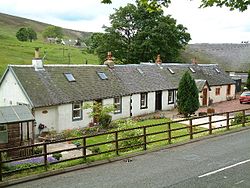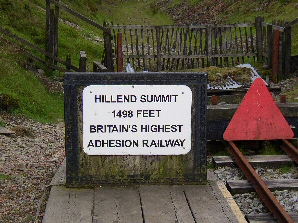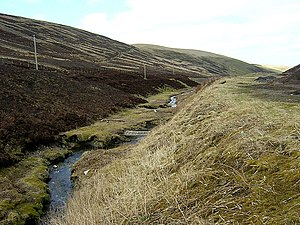Leadhills
| Leadhills | |
| Lanarkshire | |
|---|---|
 Cottages in Leadhills | |
| Location | |
| Grid reference: | NS885150 |
| Location: | 55°24’58"N, 3°45’46"W |
| Data | |
| Population: | 315 |
| Post town: | Biggar |
| Postcode: | ML12 |
| Local Government | |
| Council: | South Lanarkshire |
Leadhills is a village in Lanarkshire, six miles south-west of Elvanfoot. It was originally known as Waterhead and was settled for the accommodation of miners.[1]
It is the second highest village in Scotland at an average height of 1,460 ft above sea-level (although the Ordnance Survey are currently remeasuring the height of the village and neighbouring Wanlockhead as it is now thought Leadhills is the lower of the two), near the source of Glengonnar Water, an affluent of the River Clyde.
Contents
Local attractions
Library
The Leadhills Miners' Library (also known as the Allan Ramsay Library or the Leadhills Reading Society), founded in 1741 by 21 miners, the local schoolteacher and the local minister, specifically to purchase a collection of books for its members’ mutual improvement[2][3] — its membership was not restricted to the miners; several non-miners, such as William Symington, John Brown (author of Rab and his Friends) and James Braid, were also full members — houses an extensive antiquarian book collection, local relics, mining records and minerals. The library is the oldest subscription library in the British Isles;[4] and is of significant historical and geological importance.
In the late eighteenth century, Peterkin observed the library had “as many valuable books as might be expected to be chosen by promiscuous readers”; he found its members to be “the best informed, and therefore the most reasonable common people that I know” (1799, p. 99); and, in 1823, “J”, observing that “every miner can read, and most of them can write tolerably well”, noted the library had around 1,200 volumes, all of which “have been entirely chosen by [the members] themselves”, and that:
- As the miners work only six in the twenty-four hours in the mines, and as the barrenness of the soil affords little scope for agricultural pursuits, they have of course abundance of time for reading: and I believe they generally employ it to good purpose; for many of them can converse upon historical, scientific, and theological points so as to astonish a stranger; and even on political questions, they express their opinions with great acuteness and accuracy.[5]
Today, the library is open from May to September on weekends and bank holidays, between 2 pm and 4 pm.
Grouse moors
The grouse moors cover in excess of 11,000 acres around Leadhills and are considered to be amongst the finest in Scotland.
Golf course
Leadhills Golf Course, instituted in 1891, is the highest in Scotland. The nine hole course offers considerable challenge as the winds can be high and unpredictable as they are channelled between the hills.
Grave of John Taylor
The grave of John Taylor is also available to visit in the cemetery. Reputed to be 137 years of age at the time of his death, Taylor's grave (shared with his son, Robert) even attracted the attention of the BBC.[6]
Scots Mining Company House
The Scots Mining Company House was built in 1736 for James Stirling, the managing agent of the Scots Mining Company. It is attributed to the architect William Adam and is now a category A listed building.[7]
Leadhills & Wanlockhead Railway
The Leadhills & Wanlockhead Railway runs at weekends only and at Christmas sees the "Santa Express" which includes a ride on the train, a visit to Santa down the lead mine and a story read by "Mrs Kringle" in the Museum of Lead Mining, Wanlockhead. The Elvanfoot railway station was on the Caledonian Railway]main line from Glasgow to the south. A branch from there ran through Leadhills to Wanlockhead and operated until 1939. Part of the route has been reused by the Leadhills & Wanlockhead Railway. The railway is 1,498 ft above sea level.
Footnotes
- ↑ Sinclair, John (1799). The Statistical Account of Scotland: Drawn Up from the Communications of the Ministers of the Different Parishes. 21. Edinburgh: William Creech. p. 98. http://books.google.com.au/books?id=FDctAAAAYAAJ&dq=%22with%20regard%20to%20Leadhills%22&pg=PA98#v=onepage&q=water-head&f=false.
- ↑ On his 1841 visit to Leadhills, the statistician and school inspector Joseph Fletcher was so impressed with the Leadhills’ Reading Society that he included its "Articles and Laws" in his report to the Children's Employment Commission (they appear at Fletcher, 1842, pp. 874-878).
- ↑ "The inhabitants [of Leadhills], though chiefly employed in the severe labour of mining, are an enlightened set of people, having a pretty extensive subscription library, and exhibiting a zeal in the acquisition of useful knowledge perfectly astonishing" (Chambers & Chambers (1844), p.701.
- ↑ Foster & Sheppard (1995), p.41.
- ↑ “J” (1823), p.27.
- ↑ BBC Radio 4: Making History (23 November 2004): John Taylor, the ancient lead miner - could he really have been 137?
- ↑ "Scots Mining Company House". Historic Scotland. http://data.historic-scotland.gov.uk/pls/htmldb/f?p=2200:15:0::::BUILDING:732. Retrieved 16 March 2012.
Outside links
| ("Wikimedia Commons" has material about Leadhills) |
- - Local information on Leadhills
- http://www.leadhills.com
- http://www.leadhillsonline.org.uk/
- http://www.lowtherhills.com - Old photos of winters in Leadhills.
- Andrew, M. 2007, The Leadhills and Wanlockhead Railway (Online), Available from: "The Leadhills and Wanlockhead Railway" website
- Meadowfoot Cottage. Date Unknown, Leadhills (Online), Available from: "Leadhills" website
- Video and commentary on the Leadhills & Wanlockhead Railway.

